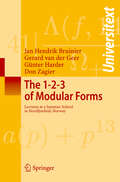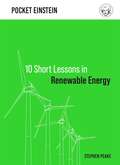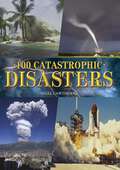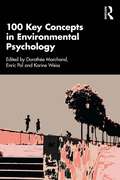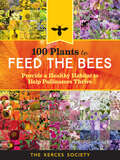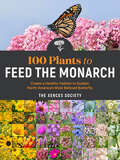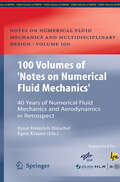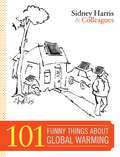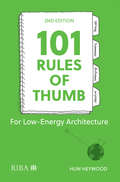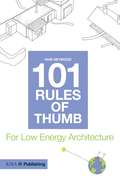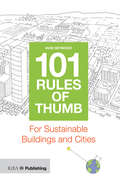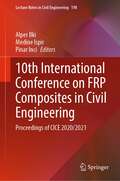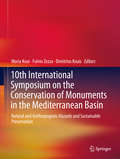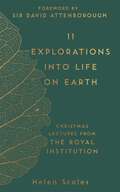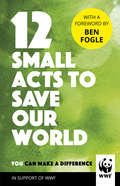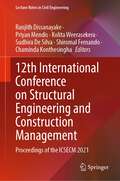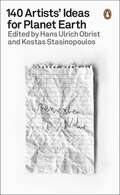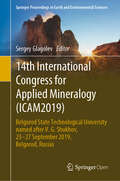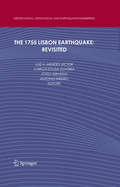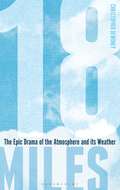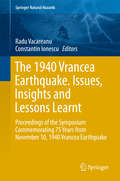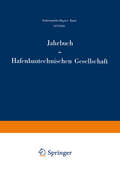- Table View
- List View
The 1-2-3 of Modular Forms: Lectures at a Summer School in Nordfjordeid, Norway (Universitext)
by Jan Hendrik Bruinier Gerard van der Geer Günter Harder Don ZagierThis book grew out of three series of lectures given at the summer school on "Modular Forms and their Applications" at the Sophus Lie Conference Center in Nordfjordeid in June 2004. The first series treats the classical one-variable theory of elliptic modular forms. The second series presents the theory of Hilbert modular forms in two variables and Hilbert modular surfaces. The third series gives an introduction to Siegel modular forms and discusses a conjecture by Harder. It also contains Harder's original manuscript with the conjecture. Each part treats a number of beautiful applications.
10 Short Lessons in Renewable Energy
by Stephen Peake'[An] impressively comprehensive, concise introduction to the biggest challenge facing us all – how to get our act together to keep our only planet habitable, for ourselves, our descendants and the living nature we depend on.' Walt Patterson____________‘"Energy" might be a short word, but it's a very big subject, and indeed one of the most important facing our world today. Understanding the ins and outs of how we make the transition to clean energy is a vital modern competence. Stephen Peake provides a top briefing. Informative, accessible and comprehensive, it is a must read for anyone interested in the future of our planet.’ Tony Juniper CBE____________‘The author says it all in his introduction: "Renewable energy powered our lives long before fossil fuels and will do so long after." As successive nations and corporations commit to net zero, the idea of getting our useful work done using clean non-depleting resources is of paramount importance. This witty, wide-ranging yet succinct guide provides a whistle-stop tour of the principal renewable energy technologies and places them elegantly in the contemporary economic, social and political context.’ Jonathan Scurlock, Chief Adviser, Renewable Energy and Climate Change at the National Farmers’ Union–––––––––––––Professor Stephen Peake takes us on a guided tour of the ten most essential aspects of this timely and fast-moving science, examining the transition from fossil fuels to clean energy that lies at the heart of a brighter climate future.Renewable energy is central to managing climate change and our transition to a sustainable energy supply for the 10 billion of us who will populate the earth by 2050. But how will we cope without fossil fuels to heat, cool and light our buildings, power our industry and run our transport systems? And are some renewables better than others? 10 Short Lessons in Renewable Energy distils the key issues of this timely subject, examining how we can harness the power of a range of groundbreaking energy technologies most effectively to achieve a sustainable energy future.About the series: The Pocket Einstein series is a collection of essential pocket-sized guides for anyone looking to understand a little more about some of the most important and fascinating areas of science in the twenty-first century. Broken down into ten simple lessons and written by leading experts in their field, discover the ten most important takeaways from those areas of science you’ve always wanted to know more about.
100 Catastrophic Disasters
by Nigel Cawthorne100 Catastrophic Disasters is an astounding compendium of natural and man-made disasters. The range of entries is extraordinary, from the bizarre to the horrific, and from the heartbreaking to the ridiculous.The book includes some of history's most incredible disasters and tells in vivid detail the story of events of people involved, the impact of particular disasters and the destruction and sorrow they left in their wake. From the eruption of Vesuvius and destruction of Pompeii, to the San Francisco earthquake of 1906, from the raging flames of the Great Fire of London to the horror of Chernobyl, every event is chronicled in fascinating detail.100 Catastrophic Disasters is a gripping and compelling account of some of the worst tragedies ever to happen in history, but also reveals some incredible stories of human courage and fortitude in the face of adversity.
100 Key Concepts in Environmental Psychology
by Dorothée MarchandThis accessible book defines 100 key concepts, ideas and processes in Environmental Psychology to provide an introductory reference work that brings together research and theory in a bite-size format. With contributions from leading figures within Environmental Psychology, each concept is clearly defined and explained within the context of issues around the environment, sustainability, climate change, nature and architecture. This book considers the involvement of psychological, physiological and social processes to understand the mechanisms that explain and contribute to the evolution of behavior and attitudes that relate to our relationship with the environment. Concepts covered include biodiversity, eco-anxiety, place identity, sustainable behaviour, climate justice and environmental attitudes. By integrating ideas from different disciplinary orientations in the field of Environmental Psychology, this book allows for a better understanding of the processes related to the individual-environment relationship, as well as the applications that they allow for in various fields of intervention. This is essential reading for students and researchers in Environmental Psychology, Sustainability Studies, Architecture and Built Environment Studies and related fields.
100 Key Concepts in Environmental Psychology
This accessible book defines 100 key concepts, ideas and processes in Environmental Psychology to provide an introductory reference work that brings together research and theory in a bite-size format. With contributions from leading figures within Environmental Psychology, each concept is clearly defined and explained within the context of issues around the environment, sustainability, climate change, nature and architecture. This book considers the involvement of psychological, physiological and social processes to understand the mechanisms that explain and contribute to the evolution of behavior and attitudes that relate to our relationship with the environment. Concepts covered include biodiversity, eco-anxiety, place identity, sustainable behaviour, climate justice and environmental attitudes. By integrating ideas from different disciplinary orientations in the field of Environmental Psychology, this book allows for a better understanding of the processes related to the individual-environment relationship, as well as the applications that they allow for in various fields of intervention. This is essential reading for students and researchers in Environmental Psychology, Sustainability Studies, Architecture and Built Environment Studies and related fields.
100 Plants to Feed the Bees: Provide a Healthy Habitat to Help Pollinators Thrive
by The Xerces SocietyIn an at-a-glance, photo-driven format, 100 Plants to Feed the Bees presents 100 nectar- and pollen-rich plants that home gardeners can cultivate to create a more bee-friendly world.
100 Plants to Feed the Monarch: Create a Healthy Habitat to Sustain North America's Most Beloved Butterfly
by The Xerces SocietyThis practical, inspiring guide shows how individuals can help support the endangered North American monarch butterfly, with information on creating monarch-friendly landscapes using plants that feed and sustain the butterfly through the different stages of its life.
100 Volumes of 'Notes on Numerical Fluid Mechanics': 40 Years of Numerical Fluid Mechanics and Aerodynamics in Retrospect (Notes on Numerical Fluid Mechanics and Multidisciplinary Design #100)
by Ernst-Heinrich Hirschel Egon Krause101 Funny Things About Global Warming
by Sidney HarrisIn this unexpectedly refreshing look at today's most inconvenient truths, acclaimed cartoonist Sidney Harris looks at global warming, with a little help from his friends. Featuring never-before-seen work from artists like long-time New Yorker contributors Matt Diffee, Sam Gross, and Lee Lorenz, among others, 101 Funny Things About Global Warming makes light of hot-button environmental issues, like unreliable hybrid cars, pie-in-the-sky alternative energy sources, and the existential crisis of our own biodegradable nature. Provocative, timely, and endlessly funny, 101 Funny Things About Global Warming fits into the growing trend of ecocentric public events and media coverage by pointing out in black and white how far we've come-and how far we still have to go-in improving the state of the world. "Great comedy can make you laugh and open your mind at the same time, and 101 Funny Things About Global Warming succeeds at both."-Global Warming Activist and Producer Laurie David Praise for Sidney Harris: "The humor in science that is most widely laughed at comes from nonscientists, like the cartoonist, Sidney Harris."-New York Times Book Review "Harris is a treasure."-American Scientist "What's so funny about science? Sidney Harris, that's what."-Isaac Asimov
101 Rules of Thumb for Low-Energy Architecture
by Huw HeywoodBuildings and construction are a major contributor to the climate and biodiversity emergency. They account for nearly 40% of energy-related carbon dioxide (CO2) emissions. It is more important than ever for architects to design responsibly and create low-carbon, low-energy buildings for a sustainable future. 101 Rules of Thumb sets out the essential elements of low-energy architecture in a fresh, intuitive way. Where ever-changing technology and complex legislation can cloud the designer’s thought-process, this book equips you with the fundamentals you need to minimise CO2 emissions, design for low-energy use and work with, not against, the forces of nature. With reliable, simple rules of thumb, each page focuses on a single piece of guidance along with a clear hand-drawn illustration. The emphasis is on passive low-energy principles, and the rules of thumb cover all the design fundamentals from site and location to orientation and form, peppered with ideas to help the designer think outside the box, drawing inspiration from traditional methods, photoperiodic plants, and the black-tailed prairie dog. An extended, fully updated narrative bibliography explores the sources in detail and provides a valuable springboard for further study. Applicable throughout the world in any climate region, 101 Rules of Thumb is a global primer to be dipped into at any time as a quick means of re-focusing on what’s important when designing a new or retrofitted low-energy building. The rules cover: Site and location Orientation and form The low-energy building envelope Carbon free heating, cooling and lighting Passive low-energy principles.
101 Rules of Thumb for Low-Energy Architecture
by Huw HeywoodBuildings and construction are a major contributor to the climate and biodiversity emergency. They account for nearly 40% of energy-related carbon dioxide (CO2) emissions. It is more important than ever for architects to design responsibly and create low-carbon, low-energy buildings for a sustainable future. 101 Rules of Thumb sets out the essential elements of low-energy architecture in a fresh, intuitive way. Where ever-changing technology and complex legislation can cloud the designer’s thought-process, this book equips you with the fundamentals you need to minimise CO2 emissions, design for low-energy use and work with, not against, the forces of nature. With reliable, simple rules of thumb, each page focuses on a single piece of guidance along with a clear hand-drawn illustration. The emphasis is on passive low-energy principles, and the rules of thumb cover all the design fundamentals from site and location to orientation and form, peppered with ideas to help the designer think outside the box, drawing inspiration from traditional methods, photoperiodic plants, and the black-tailed prairie dog. An extended, fully updated narrative bibliography explores the sources in detail and provides a valuable springboard for further study. Applicable throughout the world in any climate region, 101 Rules of Thumb is a global primer to be dipped into at any time as a quick means of re-focusing on what’s important when designing a new or retrofitted low-energy building. The rules cover: Site and location Orientation and form The low-energy building envelope Carbon free heating, cooling and lighting Passive low-energy principles.
101 Rules of Thumb for Low Energy Architecture (PDF)
by Huw Heywood101 Rules of Thumb sets out the essential elements of low energy architecture in a fresh, intuitive way. In an area where ever-changing technology and complex legislation and can cloud the designer’s thought-processes, this book encourages the designer to think clearly and intuitively about the fundamentals of low energy buildings. With reliable, simple rules of thumb that will provide new ideas and refresh the designer’s palette, each page focuses on a single piece of advice or guidance along with a clear hand-drawn illustration, while there are also plenty of tips and more detailed information for those who wish to dig deeper. The emphasis is on passive low-energy principles, and the rules of thumb cover all the design fundamentals from site and location to orientation and form, peppered with some which will help the designer to think ‘outside the box’ about the design process itself.
101 Rules of Thumb for Sustainable Buildings and Cities
by Huw HeywoodPeople across the world are becoming more aware of the need for the buildings and cities they live and work in to be sustainable, but the issue of how to be sustainable can seem a confusing and complex one. These rules of thumb provide universal guidelines for the sustainable design of both buildings and the urban realm. It’s a global primer and textbook for anyone interested in understanding sustainability in the built environment, an ideal starting point for students as well as an aide memoir for more experienced readers and practitioners interested in this field.
101 Rules of Thumb for Sustainable Buildings and Cities
by Huw HeywoodPeople across the world are becoming more aware of the need for the buildings and cities they live and work in to be sustainable, but the issue of how to be sustainable can seem a confusing and complex one. These rules of thumb provide universal guidelines for the sustainable design of both buildings and the urban realm. It’s a global primer and textbook for anyone interested in understanding sustainability in the built environment, an ideal starting point for students as well as an aide memoir for more experienced readers and practitioners interested in this field.
10th International Conference on FRP Composites in Civil Engineering: Proceedings of CICE 2020/2021 (Lecture Notes in Civil Engineering #198)
by Alper Ilki Medine Ispir Pinar InciThis volume highlights the latest advances, innovations, and applications in the field of FRP composites and structures, as presented by leading international researchers and engineers at the 10th International Conference on Fibre-Reinforced Polymer (FRP) Composites in Civil Engineering (CICE), held in Istanbul, Turkey on December 8-10, 2021. It covers a diverse range of topics such as All FRP structures; Bond and interfacial stresses; Concrete-filled FRP tubular members; Concrete structures reinforced or pre-stressed with FRP; Confinement; Design issues/guidelines; Durability and long-term performance; Fire, impact and blast loading; FRP as internal reinforcement; Hybrid structures of FRP and other materials; Materials and products; Seismic retrofit of structures; Strengthening of concrete, steel, masonry and timber structures; and Testing. The contributions, which were selected by means of a rigorous international peer-review process, present a wealth of exciting ideas that will open novel research directions and foster multidisciplinary collaboration among different specialists.
10th International Symposium on the Conservation of Monuments in the Mediterranean Basin: Natural and Anthropogenic Hazards and Sustainable Preservation
by Maria Koui Fulvio Zezza Dimitrios KouisThis book addresses physical, chemical, and biological methods for the preservation of ancient artifacts. Advanced materials are required to preserve the Mediterranean belt's historic, artistic and archaeological relics against weathering, pollution, natural risks and anthropogenic hazards. Based upon the 10th International Symposium on the Conservation of Monuments in the Mediterranean Basin, this book provides a forum for international engineers, architects, archaeologists, conservators, geologists, art historians and scientists in the fields of physics, chemistry and biology to discuss principles, methods, and solutions for the preservation of global historical artifacts.
11 Explorations into Life on Earth: Christmas Lectures from the Royal Institution (The RI Lectures #2)
by Dr Helen ScalesThe second in a series of books in association with the Royal Institution on their world-renowned Christmas Lectures, this time exploring the secrets of the natural world – with a foreword by Sir David Attenborough.Following on from the success of 13 Journeys Through Space and Time, which took us on a voyage of astronomical discovery through past Christmas Lectures given at the Royal Institution on space and space exploration, this book turns our attention to our own planet and the animals, plants, fish, insects and all the other living things that inhabit it – how they’ve evolved and the vital roles they play in the intricate webs of life on earth.Taking eleven of the most exciting and revealing Christmas Lectures on the natural world given at the Royal Institution, including Sir David Attenborough’s animal-packed Lectures from 1977 and Richard Dawkins’s explosive series on the evolution of life, we take an illuminating look at more than a hundred years of scientific exploration to discover the origins of life on our planet and the mysteries so far uncovered.
12 Small Acts to Save Our World: Simple, Everyday Ways You Can Make a Difference
by Wwf Ben Fogle_______________________________— Ever wanted to save the world? —It’s easy to feel like we can’t make a difference. But small, easy actions, if taken by enough people, can move mountains – and save planets.Written in collaboration with leading environmental experts from WWF, this short book provides simple changes we can all make to our everyday lives, from morning to night.These aren’t the only things you can do. Nor are they things you have to do. But these 12 small acts are basic steps anybody can take, and if even one of them sticks, our children will inherit a better world.Acts like:– Turning off devices instead of leaving them on standby– Buying less cotton clothing (a T-shirt needs 2,400 litres of water to make!)– Using reusable straws when possible– Turning off the tap while you brush your teethwill take only moments, but if enough people commit to them, we can make a real difference to our planet._______________________________'Now really is the time to act. You don’t have to be a superhero – everyone can make a difference by following this book’ – Ben Fogle
12th International Conference on Structural Engineering and Construction Management: Proceedings of the ICSECM 2021 (Lecture Notes in Civil Engineering #266)
by Ranjith Dissanayake Priyan Mendis Kolita Weerasekera Sudhira De Silva Shiromal Fernando Chaminda KonthesinghaThis book highlights advances in the fields of civil engineering and construction industry with a particular focus on Structural Engineering and Construction Management. This book consists of top quality and innovative research papers selected from the proceedings of the 12th ICSECM 2021 under the themes of Innovations in Building Materials, Construction Management, Tall buildings, Concrete Technology and High Performance concrete, Geotechnical Engineering, Water and Waste Water Treatment, CKDu problem in Sri Lanka, Structural Health Monitoring & Design of Resistive Structures, Disaster Risk Reduction and Resilience in the Built Environment, Fibre Reinforced Polymer, Life Cycle Assessment of Buildings and Fire Safety Engineering.
140 Artists’ Ideas for Planet Earth
by Hans Ulrich Obrist Kostas StasinopoulosThrough 140 drawings, thought experiments, recipes, activist instructions, gardening ideas, insurgences and personal revolutions, artists who spend their lives thinking outside the box guide you to a new worldview; where you and the planet are one.Everything here is new. We invite you to rip out pages, to hang them up at home, to draw and scribble, to cook, to meditate, to take the book to your nearest green space.Featuring Olafur Eliasson, Etel Adnan, Alexis Pauline Gumbs, Jane Fonda & Swoon, Judy Chicago, Black Quantum Futurism Collective, Vivienne Westwood, Cauleen Smith, Marina Abramovic, Karrabing Film Collective, and many more.
14th International Congress for Applied Mineralogy: Belgorod State Technological University named after V. G. Shukhov, 23–27 September 2019, Belgorod, Russia (Springer Proceedings in Earth and Environmental Sciences)
by Sergey GlagolevThis open access proceedings of the 14th International Council for Applied Mineralogy Congress (ICAM) in Belgorod, Russia cover a wide range of topics including applied mineralogy, advanced and construction materials, ore and industrial minerals, mineral exploration, cultural heritage, etc. It includes contributions to geometallurgy, industrial minerals, oil and gas reservoirs as well as stone artifacts and their preservation. The International Congress on Applied Mineralogy strengthens the relation between the research on applied mineralogy and the industry.
The 1755 Lisbon Earthquake: Revisited (Geotechnical, Geological and Earthquake Engineering #7)
by João Azevedo A. Ribeiro Luiz Mendes-Victor Carlos Sousa OliveiraThe 1755 earthquake and tsunami were influential not only in Portugal but in all European and North African countries where the devastating effects were felt. The entire world was deeply impressed and the discussion of its causes generated a large amount of scientific and metaphysical speculation. It inspired philosophers, poets and writers. The socio-economic consequences of the event were great and affected the future organization and development of Portugal. The possibility of a similar occurence urges society and the scientific community to reflect on its lessons. AudienceThis work is of interest to experts in seismology, earthquake engineering, civil protection, urban planning and it is a reference book for doctoral students.
18 Miles: The Epic Drama of the Atmosphere and its Weather
by Christopher DewdneyWe live at the bottom of an ocean of air – 5,200 million million tons, to be exact. It sounds like a lot, but Earth's atmosphere is smeared onto its surface in an alarmingly thin layer. Shrink the earth to the size of a basketball and our atmosphere would be as thick as a layer of food wrap – 99 percent contained within 18 miles. Yet, within this fragile margin lies a magnificent realm – at once gorgeous, terrifying, capricious, and elusive. 18 Miles is a kaleidoscopic and fact-filled journey through our atmosphere and weather. Beginning with the birth of Earth's atmosphere and what would be a typical weather report from three billion years ago, author Chris Dewdney looks at each of the components in our air and reveals to us the invisible rivers in the sky that affect how our weather works and the structure of clouds and storms and seasons, the rollercoaster of climate. He details the history of weather forecasting, looking at weather events from ancient history to the present day, and introduces us to the eccentric and determined pioneers of science and observation whose efforts gave us the understanding of weather we have today. Throughout history, humanity has been obsessed with the weather and the atmosphere – as both evocative metaphor and physical reality. We have been determined to find reliable ways to predict our seemingly unpredictable weather, and in the 21st century, faced with the challenges of climate change, it is more important than ever that scientists are able to study our atmosphere and work out how and why humanity has affected it. From the roaring winds of Katrina to the frozen oceans of Snowball Earth, Dewdney entertains as he gives readers a long overdue look at the very air we breathe.
The 1940 Vrancea Earthquake. Issues, Insights and Lessons Learnt: Proceedings of the Symposium Commemorating 75 Years from November 10, 1940 Vrancea Earthquake (Springer Natural Hazards)
by Radu Vacareanu Constantin IonescuThese proceedings include most of the available information on this major seismic event and its consequences. With an estimated moment magnitude of 7.7 and a heavy toll in terms of human and economic losses, it ranks as the largest intermediate-depth earthquake in Europe in the twentieth century. Nevertheless, because of the difficult conditions in the 1940s, the lessons learnt after the Vrancea earthquake were not extensively shared with the international scientific community and thus, this book fills a gap in the literature discussing the knowledge acquired after major disasters. Past experience together with current understanding of the 1940 Vrancea earthquake are presented along with the latest information on Romanian seismicity, seismic hazard and risk assessment, and seismic evaluation and rehabilitation of buildings and structures. Moreover, it includes excerpts from Romanian post-disaster reports and textbooks concerning the earthquake.
